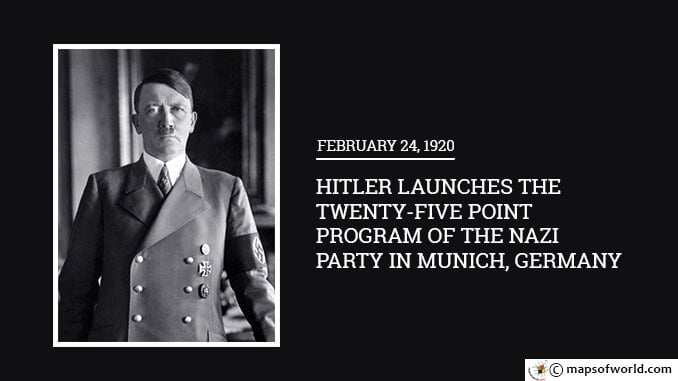On February 24, 1920, Hitler put forward the twenty-five point program – the key agenda of the Nazi Party in Munich, Germany. In 1919, with the end of World War I, Germany suffered much more than the injured pride. The bitter pill of defeat was reiterated by the harsh terms of the Treaty of Versailles that enjoined that Germany and its people not only take up responsibility for the destruction and death caused by the Great War but also pay huge reparations to the Allied Powers. This broke the back of the German economy but also had an unexpected side-effect. It gave rise to a latent nationalism – a need to blame the defeat on some sections of the German society such as the Jews, the Communists, and the betrayal of the politicians who signed the Treaty of Versailles. Anton Drexler, the far-right politician and influential leader of Germany, went on to set up the German Workers’ Party (Deutsche Arbeiterpartei – DAP) in January 1919, cutting across regional divides. At the time only about two dozen joined the party. Some of the early members included Hermann Esser, Gottfried Feder, and Dietrich Eckart. In May 1919, Captain Karl Mayr, Adolf Hitler’s immediate senior at the Reichswehr Army Intelligence Division received his appointment as the head of the German Education and Propaganda Department. He soon enlisted Hitler’s assistance as a spy to attend the German Workers’ Party’s meetings. Hitler attended his first DAP meeting in mid-September that year. Hitler found the party’s anti-Semitic agenda quite in line with his own but when invited by Drexler, was reluctant to join since he had dreamed of founding his own party and not joining one that already existed. Urged by General Erich Ludendorff, however, Hitler joined the party as the 55th member; he soon became the 7th executive member of the party’s central committee. Hitler’s oratorical skills soon made him the central attraction of the DAP. One of the earliest meetings Hitler helped organize was held on October 16, 1919. A little over a hundred people showed up, spurred on by an advertisement placed in a popular anti-Semitic newspaper. It was here that the party and indeed Hitler himself discovered his oratorical skills. He whipped up a frenzy at the Munich beer cellar and gained a donation of over three hundred marks. In the days to come his speeches attracted increasing attendance and brought much money to buy up more advertisements and propaganda space. Hitler spoke of the injustice meted out at Versailles, blaming Jews for both the defeat and the nation’s problems. He managed to influence senior army leader Ernst Rohm to the party, bringing to its disposal army funds. By 1920, Hitler had started to dream of taking over the party. He knew that his oratory alone had caused the ranks of the party members to bulge in numbers. He started to organize for the largest meeting of the party as yet – with almost 2,000 people in attendance. On February 24, 1920, Hitler addressed this large meeting hall in Munich and enkindled the listeners with his speech. It was here that he announced the change of the party’s name to the Nationalsozialistische Deutsche Arbeiterpartei (National Socialist German Workers Party – NSDAP) – Nazi Party. The meeting became very important in history for another reason – the announcement of the Nazi Party’s twenty-five point program. The program became one of the Nazi Party’s key objectives and propaganda vehicle. Hitler and the Nazi Party called for disengaging from the terms of the Treaty of Versailles which had been imposed on Germany. Hitler called for the establishment of a dominant German empire and endorsed annexation of the erstwhile colonies. This would eventually translate into an increase in the military powers and rearmament of Germany. The program also called for the denouncement of the Jews as German citizens and advocated that all Jews in important positions of German society to be evicted. A ban on foreign, especially Allied, travel and trade into the country was called for. Communism was deemed the enemy and the party promised a complete reorganization of education, press, and enterprise. Major land reforms and economic restructuring were promised. The twenty-five point program was the only positive agenda put forth by the Nazi Party and on its basis, the party gathered not only a mass following but also raised an army that would later go on to become the Sturmabteilung (‘Storm Battalion’; SA). Hitler soon took complete control over the NSDAP and steered the party towards national dominance. Within the following decade, the Nazi Party became the second-largest party in Reichstag. Adolf Hitler went on to be appointed as the Chancellor of Germany in 1933. This was the beginning of the Nazi Party’s takeover of the German government. You may also like : February 24 1917 – The Zimmermann Telegram is Passed to the United States by British Authorities
February 24 1920 – Hitler launches the twenty-five point program of the Nazi Party in Munich, Germany
On February 24, 1920, Hitler put forward the twenty-five point program – the key agenda of the Nazi Party in Munich, Germany. In 1919, with the end of World War…
412
